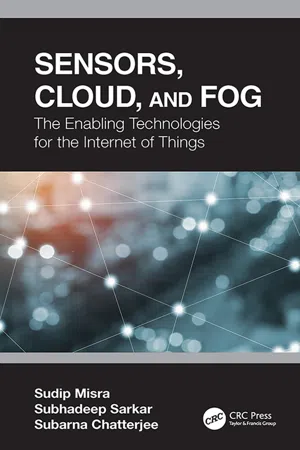
Sensors, Cloud, and Fog
The Enabling Technologies for the Internet of Things
- 262 pages
- English
- ePUB (mobile friendly)
- Available on iOS & Android
Sensors, Cloud, and Fog
The Enabling Technologies for the Internet of Things
About This Book
This book provides an in-depth understanding of Internet of Things (IoT) technology. It highlights several of today's research and technological challenges of translating the concept of the IoT into a practical, technologically feasible, and business-viable solution. It introduces two novel technologies--sensor-cloud and fog computing--as the crucial enablers for the sensing and compute backbone of the IoT. The book discusses these two key enabling technologies of IoT that include a wide range of practical design issues and the futuristic possibilities and directions involving sensor networks and cloud and fog computing environments towards the realization and support of IoT.
Classroom presentations and solutions to end of chapter questions are available to instructors who use the book in their classes.
Frequently asked questions
Information
INTRODUCTION I
Chapter 1
History and Evolution of Cloud Computing
1.1 Introduction
1.1.1 Classification of Cloud Computing
1.1.2 Cloud Computing Deployment Models

- Public: In this type of cloud deployment [3–7], the entire computing infrastructure is available to the customers publicly over the Internet, as shown in Figure 1.1. Some examples of public cloud deployments are Amazon Web Services (AWS), Microsoft Azure, and Google Cloud Platform. For example, end-users can obtain the services of VMs, cloud storage, or application processing; the services can be free or payable based on the use. It is a multi-tenant virtualized environment for sharing and provisioning of resources. It demands a high bandwidth and large storage for transmitting services and redundant replication of stored data.
- It mitigates the requirements of investment and periodic maintenance of on-premise IT resources [2,8].
- There is less resource wastage, as customers can simply pay for the consumed resources.

- It has all the advantages of public cloud infrastructures.
- The company can maintain full-fledged control of the resources and the hardware layer of the cloud servers.


1.1.3 Cloud Computing Service Models
- Software as a service (SaaS): In SaaS cloud models [23–26], providers offer software services in terms of complete products. The end-users are abstracted from the back-end processing and provisioning mechanisms, and they simply do not need to install or maintain the software. SaaS is provisioned in a way to benefit cloud customers to access and utilize any software over the Internet without worrying about the specification, configuration, or internal details of the software, as shown in Figure 1.5. Some typical examples include Google Apps and Cisco WebEx.
- Platform as a service (PaaS): PaaS cloud deployment models [14,27,28] are generally targeted to developers who intend to build applications on specific platforms. Figure 1.5 shows that PaaS enables easy, quick, and convenient management of applications by the developers. Windows Azure, Google App Engine, and Apache Stratos are popular examples of PaaS models.
- Infrastructure as a service (IaaS): IaaS cloud services [30–32] are primarily utilized for managing applications. The services of IaaS cloud include access and utilization of storage, virtualization, hardware, and network resources, as shown in Figure 1.5. Some common examples of IaaS are AWS, Cisco Metapod, and Microsoft Azure.

1.2 Computation in Cloud

1.2.1 Resource Management
1.2.1.1 Workload Models
Table of contents
- Cover
- Half Title
- Title Page
- Copyright Page
- Dedication
- Table of Contents
- Foreword
- Preface
- Acknowledgments
- About the Authors
- PART I: INTRODUCTION
- PART II: THE SENSOR-CLOUD PARADIGM
- PART III: FROM THE CORE TO THE EDGE: FOG
- Index